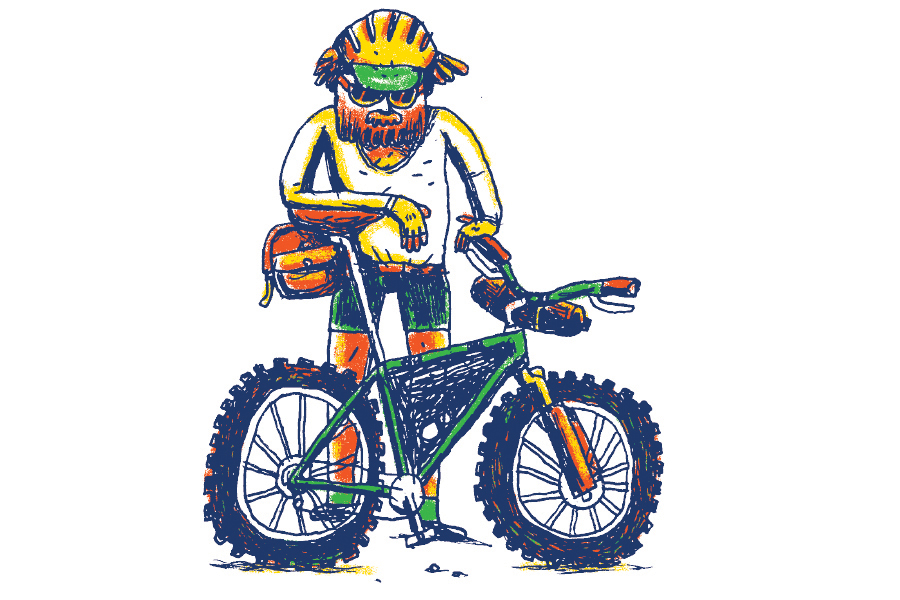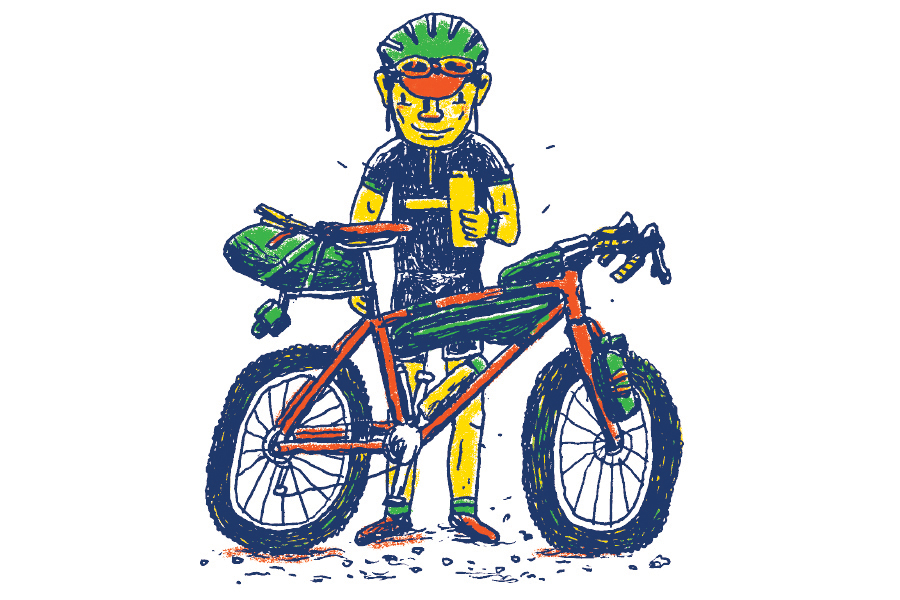Touring Bike Buyers Guide: Geometry
The hardest part in writing a touring bike buyers guide is in first defining the term “touring bike.” After all, nearly any bicycle can and has been used for a tour. For that matter, what exactly is a bicycle tour? For many of us, touring evokes the image of a dropbar bicycle with front and rear racks and panniers on a long and winding paved road. For others, a touring bike is a means of transport between hotels or B&Bs, lightly loaded with a set of clothes and essentials. And for the dustier crowd, the conjured bicycle has fat off-road tires, flat bars, and a collection of soft luggage strapped to the handlebars, frame, and saddle.
The bike and equipment needs for each of these cases vary drastically. To recommend a classic touring bike — with its long and low geometry and abundant rack and fender options — to you with aspirations for supported trips or weekend rides is to deny you the pleasure of a lighter, more spirited bicycle. Likewise, a mountain bike or bikepacking rig like Kona’s Sutra LTD will also function as a rack and pannier machine, but if the bike never sees dirt it may be a poor recommendation.
Because the touring bike category is expanding (at last!), it’s important for you to audit your own needs and preferences and recognize that not all advice is directed at you. Just as important is to realize that there are no hard-and-fast rules, and no single parameter that guarantees success when touring. So have an honest look at how you ride and where you want to explore before diving into the rest of this feature. Self-reflection will serve you well and maybe even save you some money.
Frame and Fork Geometry for Touring
The last 10 years have seen extensive evolution in the realm of bicycle geometry. While much of the most radical change has been in the mountain bike world, the road and touring scenes have also experienced some significant shifts. Notably, endurance road bikes — with taller head tubes, lower bottom brackets, and more stable geometry — are now ubiquitous. Gravel bikes have also blasted onto the dropbar scene with increased tire clearances, disc brakes, thru-axles, and plentiful accessory mounting locations. Bikepacking machines, often dropbar 29ers like the Salsa Fargo, are now available from a whole slew of manufacturers. To say that touring cyclists have options is an understatement in 2019.
This raises the question of whether classic touring geometry is still relevant. Before we answer that, let’s have a quick refresher on what that looks like and, more importantly, why those geometry figures have settled where they are.
Traditional touring bike geometry is typified by a slack head tube angle, high trail numbers, long chainstays, a long wheelbase, and a low bottom bracket. Each of these has a function or an intention behind it. The slack head tube angle and high trail figures make for predictable, stable steering even with a front and rear load. Long chainstays keep the rear panniers away from a rider’s heels and increase the overall wheelbase, further increasing stability. The low bottom bracket lowers the rider’s center of gravity, reduces the distance from the saddle to the ground, and enhances straightline riding.
To put these ideas into figures, let’s look at two popular examples that typify touring geometry — Surly’s Disc Trucker and Trek’s 520. Here are the important handling numbers for the 56cm 700c Surly and 57cm Trek:
| Trek 520 57cm | Surly Disc Trucker 56cm (700c) | |
| Head Tube Angle | 71.8° | 72° |
| Fork Offset | 52mm | 45mm |
| Trail | 61mm (with 38mm tire) | 67mm (wth 37mm tire) |
| BB Drop | 70mm | 78mm |
| Chainstay | 450mm | 460mm |
| Wheelbase | 1052mm | 1055.6mm |
In addition to these geometry figures, touring bikes are built with heavier tubing to handle the increased load of front and rear luggage. While certainly vital to the safety of a touring bike, this also has an impact on the ride quality and comfort of the bike, especially when ridden without a load.
It’s important to recognize that the combination of these geometry and construction cues results in the handling manners of a touring bike. No single facet of bicycle geometry or construction is a magic bullet. Instead, think of them as interplaying — each geometry figure impacts the next.
When we look at other options that are gaining use in touring circles, namely gravel, mountain, and bikepacking bikes, there are geometry differences, and with good reason. These bikes are designed with a different sort of riding in mind, but that doesn’t mean they should be dismissed for touring. In fact, depending on how you tour, they may suit your needs better than a “classic” touring bike.
In the case of gravel, manufacturers are looking for a blend of stability, responsiveness, and maneuverability. But design philosophies vary widely in this still-emerging category. Some gravel machines are trending toward mountain bike geometry (Salsa Warbird) with higher trail numbers, while others (Allied Allroad) are designed to mimic the handling of a road bike but with the added traction and comfort of wider tires. Because of this, you’ll want to look closely at the geometry of any potential gravel purchase if you intend to use it for touring. Our examples below illustrate the differences. The Warbird is more likely to provide stable handling once a load is added (it also features front and rear rack compatibility). The Allied, while a great bike, is aimed at more performance-oriented riding and won’t fare as well with a touring load (never mind that it doesn’t have rack mounts).
Generally, a gravel bike will have shorter chainstays, limited only by drivetrain and tire clearances, than a touring bike. Bottom brackets are kept low to maintain stability, with many of them actually lower than a touring bike because of the larger tires used. Headtube angles and fork offsets (and subsequently trail figures) vary widely among gravel bikes.
| Salsa Warbird 56cm | Allied Alfa Allroad 56cm | |
| Head Tube Angle | 70.75? | 73° |
| Fork Offset | 50mm | 48mm |
| Trail | 71mm (with 40mm tire) | 55mm (wth 35mm tire) |
| BB Drop | 70mm | 69mm |
| Chainstay | 430mm | 420mm |
| Wheelbase | 1038.2mm | 1007mm |

Modern mountain bikes have far slacker head tube angles, which are needed when tackling downhill trails at full tilt, than a touring bike. Chainstays are kept as short as possible in order to aid climbing. And bottom bracket heights, compared to a touring bike, are raised to increase clearance between crank arms and trail obstacles. Here are a couple of examples of hardtail (front suspension) mountain bikes for comparison. Both use the 29er wheelsize and are listed in the size equivalent to a 56cm dropbar bike. The Specialized is more XC-oriented with quicker steering and a 100mm travel fork, while the Niner, with a 120mm travel fork, is made with more aggressive technical riding in mind. Both would make excellent bikepacking bikes. The Niner even features rear rack mounts.
| Specialized Chisel Expert L | Niner SIR 9 L | |
| Head Tube Angle | 69.8° | 68° |
| Fork Offset | 51mm | 51mm |
| Trail | 83mm (with 2.3in. tire) | 97mm (wth 2.4in. tire) |
| BB Drop | 57.5mm | 52mm |
| Chainstay | 430mm | 430mm |
| Wheelbase | 1128mm | 1162mm |

Bikepacking bikes are perhaps the closest in their geometries to a touring bike, but with added tire clearance and mountain bike–inspired handling and bottom bracket heights. Again, there are reasons for these changes. Below are two dropbar options. It’s interesting to see such drastic differences in trail between the Kona and the Salsa. But chainstay lengths are identical with the sliding dropout on the Fargo in its shortest position.
In addition to geometry differences are technological changes. Common among all three categories (though they are also seen on an increasing number of touring bikes) are thru-axles, which reliably position wheels with the exacting standards that are helpful with disc brakes.
If you plan on running bikepacking bags, a single rack, or using a hybrid luggage system with either a front or rear rack and bikepacking bags, then traditional touring geometry figures are likely less important. And significantly, if you only carry that much gear on rare occasions, you’ll be better served by a bike with a lighter, more compliant frame and fork.
| Kona Sutra LTD 54cm (56 effective) |
Salsa Fargo Apex 1 M | |
| Head Tube Angle | 71° | 69° |
| Fork Offset | 50mm | 45mm |
| Trail | 71mm (with 45mm tire) | 98mm (wth 2.6in. tire) |
| BB Drop | 72mm | 70mm |
| Chainstay | 445mm | 445-462mm (sliding dropouts) |
| Wheelbase | 1059mm | 1077-1093mm |
This means that the purchase of a gravel bike, especially one with rack mounts, may be more compelling for many riders than a classic touring bike. It can be used for road riding, commuting, gravel riding, cyclocross racing, and bike touring. Similarly, a bikepacking bike like Salsa’s Fargo could serve as a mountain bike, touring bike, commuter, and gravel machine. While touring bikes have historically played a jack-of-all-trades role, these new options are certainly worth exploring if you’re in the market for a new bike. This increased versatility, especially with dirt riding in mind, is appealing to many riders.
I’m not attempting to dismiss the qualities of a classically designed touring bike. To answer our first question: yes, traditional touring bike geometry is still relevant. It has taught us important lessons in how bikes handle when they’re asked to carry a load. It has also informed the design of other forms of touring bikes, those that have branched off from the rack-and-pannier tarmac model.
If you prefer a “traditional” rack and pannier setup and stick to pavement or smooth dirt roads, then a touring bike is probably still your best bet. The geometry — with its slack angles, high trail, low bottom bracket, and long chainstays — will treat you well.
But if you need one bike to rule them all, and touring is the exception instead of the rule, then why not explore your options? Perhaps you’ve come to prefer a lighter load or a combination of front racks and soft bikepacking bags. Maybe supported trips are more your style. In those cases, consider a gravel bike. If rougher roads strike your fancy, then why not have a go on a mountain bike with bikepacking bags?
This story originally appeared in the March 2019 issue of Adventure Cyclist.


